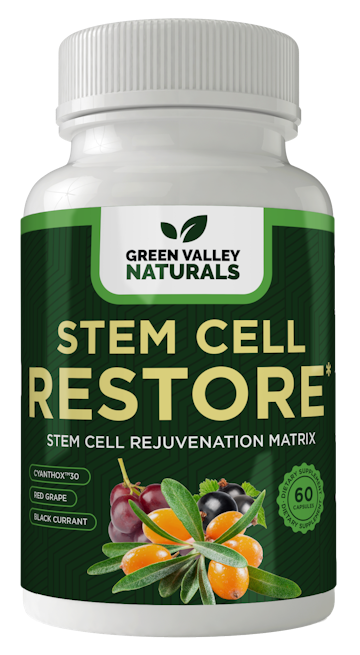
How Do Senescent Cells Cause Aging? Exploring A Root Cause of Aging and What You Can Do About It
Anti-aging scientists have many hallmarks of aging in their sight but one they’re especially excited about is targeting malfunctioning, aging cells that are the result of a process called cellular senescence.
Studies in animals show using drugs to clear away these inflammation-causing, “deadbeat” cells leads to healthier and longer lives. This method is considered so promising that more than two dozen human trials are currently in progress.
These drugs are years away from being approved but you don't have to sit on your hands. You can make simple lifestyle changes such as eating healthy foods, losing excess weight, exercising regularly and taking the right nutritional supplements to stave off senescent cells.
Key Takeaways
Senescent cells are a hallmark of aging but can be reduced or eliminated by lifestyle changes.
Good lifestyle practices also promote healthy aging and keep senescent cells at bay.
Results from early human trials on drugs called senotherapeutics to restore health, delay age-related diseases, and extend the life of animals are promising.
What Are Senescent Cells?

Your cells can be damaged via external processes such as pollutants in the air you breathe, pesticides in the food you eat, and overexposure to the sun. But damage can also arise from normal metabolic processes that take place in the body all the time.
When a cell gets damaged a repair team is summoned into action to fix the problem so it can continue to function as normal. But if the damage is so extensive it’s beyond repair, the cell is instructed to call time and commit suicide. There’s also a third option. If an aging cell can’t be repaired yet the damage isn’t so far-reaching it needs to be killed off, the aging cell can enter a state of senescence.
Scientists aren’t entirely clear why this third option exists, but the most accepted theory is that it stops a damaged, aging cell from turning into a cancer cell. Senescence achieves this by putting an emergency brake on cell division, keeping the cell in a permanent state of cell cycle arrest. This promotes tumor suppression and prevents cancer cell proliferation.
Cellular senescence also occurs at the end of a cell’s natural life. After around 50 cellular replications the cell cycle reaches exhaustion and the cell dies, or at least it should. Instead, the cell continues in a non-dividing state. How long an exhausted cell remains senescent in the human body isn’t yet known.
You might imagine a cell that survives in this zombie-like state would just float around doing nothing, but that’s not so. In fact, it’s highly metabolically active. This can be both a blessing and a curse.
Cellular Senescence – A Double-Edged Sword
Senescent cells secrete a wide range of signaling molecules - chemokines, cytokines, growth factors, proteases, extracellular matrix components - collectively called the senescence-associated secretory phenotype (SASP). Some of these can recruit the immune system to sweep senescent cells away. They also have positive roles in wound healing by secreting various factors that promote tissue repair. In addition, senescent cells are involved in embryonic development and childbirth.
However, you can have too much of a good thing.
Once people reach the age of 50, even in healthy individuals, immune cells become less efficient and immunosenescence begins. This describes an immune system that's now less able to ‘keep house’, so senescent cells start to accumulate in various tissues and organs throughout the body, making up 10 to 15 percent of cells in the elderly population.
This immune deficiency leads to an ongoing cry for help. Chronic SASP signaling gives rise to tissue damage and chronic inflammation (inflammaging) that harms neighboring cells. By these means SASP contributes to age-related diseases.
To make matters worse, cellular stress caused by pathological changes arising from these age-related diseases results in the production of more senescent cells, creating a vicious circle of harm. This inflammatory profile also leads to stem cell exhaustion. Without stem cells organs lose their ability to recover from damage and begin to fail.
As to why senescent cells operate differently across your lifespan, the latest science shows that it's most probably down to evolution. These cells optimize tissue repair and help prevent cancer to make sure you survive and are healthy enough to produce offspring. But after age 50 this is no longer a priority, leaving no mechanism in the body to deal with the harmful effects cell senescence causes in older people.
Factors Triggering Senescence
While we can point to "aging" as the biggest factor for cellular senescence, there are some root causes behind growing older which include:
Mitochondrial dysfunction: In all tissues aging is accompanied by a general decline in the function of mitochondria, the cells’ batteries that take in sugars and fats to produce energy.
Oxidative stress: An imbalance between the production of reactive oxygen species (free radicals) and the body’s capacity to detoxify them with antioxidants.
DNA damage: Both the above and other factors cause DNA damage and activate molecular pathways related to aging and senescence.
Accelerated telomere shortening: A fragment of the telomere- the protective cap at the ends of chromosomes – gets chipped away with each cell division. When it becomes too short for the stability of the chromosome the cell stops dividing and becomes senescent. Research has demonstrated that activation of a related enzyme called telomerase can extend the lifespan of certain organisms and delay the emergence of age-related diseases.
Epigenetic (related to genes) dysregulation: Genes get switched "on" or "off" as needed by compounds and proteins that make up the epigenome, which is all the factors related to your body's complete set of genes. The genome and its related proteins accumulate defects throughout life, promoting senescence.
Oncogenes: Oncogenes are genes that have mutated and have the potential to cause cancer. Although senescent cells are intended to prevent cancer, cancer promoting genes can trigger oncogene-induced senescence from the hyperactivation of oncogenes.
Centrosome dysfunction: Centrosomes are organelles - molecular complexes responsible for specific tasks in cells - located close to the nucleus. According to Dr. Qi Wu and colleagues (2020), "increasing evidence has revealed a relationship between CD (centrosome dysfunction) and senescence, suggesting that the centrosome could play a role in aging directly or indirectly."
These factors and others that cause senescence leave the body vulnerable to many age-related conditions.
Senescent Cells and Diseases of Aging
Numerous studies show how senescent cells cause disease. For example, scientists from the University of Minnesota write that senescence “plays a causal role in numerous age-related diseases including Alzheimer’s and cardiovascular diseases, osteoporosis, diabetes, renal disease, and liver cirrhosis.”
The good news is, that laboratory research suggests if you get rid of the senescent cells you get rid of the disease. In mouse models, clearing these cells led to the prevention or alleviation of diseases including:
Frailty
Osteoporosis
Atherosclerosis
Osteoarthritis
Idiopathic pulmonary fibrosis
Fatty liver disease
Type-2 diabetes/metabolic dysfunction
Neurogenerative disease
Such serious conditions underscore the importance of finding strategies to target senescent cells. We'll address these later, but first, since senescent cells are created not just in an older person but in a healthy fetus and in healthy young people, how can scientists be sure they’re a direct cause of aging?
The Impact of Senescent Cells on Aging
At one time there was a lot of skepticism and even outright hostility in the scientific community to the idea that senescent cells cause aging, until two seminal papers from the Mayo Clinic in Rochester, Minnesota were published in 2011 and 2016.
In the first, genetically engineered mice were exposed to a drug that kills senescent cells. This delayed the onset of muscle loss, cataracts and other problems that come with aging. In later life the drug slowed the progression of already established aging disorders in the mice.
In the second study, the researchers used a drug that eliminates senescent cells in normal mice. This delayed tumor formation and, in several organs, reduced age-related detrimental effects. The average lifespan of the mice was extended by between 17 and 35 percent. These mice also looked healthier with reduced inflammation in muscle, fat, and kidney tissue.
Therapeutic Approaches Targeting Senescent Cells

Drugs that target senescent cells but leave normal cells alone are called senotherapeutics. There are two different kinds of senotherapeutics: Senolytics which aim to kill senescent cells, and senomorphics which scale them down without killing them.
Senolytics: It's Never Too Late To Eliminate Senescent Cells
The Mayo Clinic’s next important study was published in 2018. They injected young mice with a small number of senescent cells. The scientists were astonished to find such small numbers of senescent cells could slash the physical function of the mice by up to half within just a few weeks!
Next, the researchers treated the mice with two strange bedfellows that target senescent cells by different mechanisms; dasatinib, a leukemia drug, and quercetin, a powerful plant antioxidant flavanol found in some fruits and vegetables. As a result, the mice recovered between 50 to 100 percent of their lost physical functions within two weeks.
The team then went on to treat old mice in the same fashion. Doing so improved their physical function by between 30 and 100 percent, and they lived a whopping 36 percent longer than old mice not given the drug combo.
Dr. James Kirkland, who led the research, said it used to be thought that once you’re old it’s too late to do anything about problems that come with aging. But it looks like “we have to rethink that.”
Richard J. Hodes, M.D., Director of the National Institute on Aging, which provided most of the funding for the research, said: “This study provides compelling evidence that targeting a fundamental aging process - in this case, cell senescence in mice - can delay age-related conditions, resulting in better health and longer life.”
About 15 senolytic drugs with various mechanisms of action have been developed, but you probably won't be able to get them for some time. That's because there’s a risk they could hinder positive aspects of senescent cells and increase the risk of cancer. Fortunately, there are numerous natural senolytics available, more on those in a minute.
But first, there's another class of senotherapeutics that has been designed called senomorphics.
Senomorphics: Making Senescent Cells Less Harmful

Senomorphics, via various signaling pathways, repress the secretions expressed by SASP to reduce the harmful effects of senescent cells without inducing cell death. By altering their behavior rather than killing them, senomorphics can potentially alleviate age-related pathologies and improve overall health with far less risk.
Sounds exciting, doesn't it?
The drug rapamycin is one well-established senomorphic that reduces cellular senescence, suppresses SASP and extends lifespan of yeast, worms, and flies. Given late in life it also extends the life of mice.
Unfortunately, the drug has serious side effects. However, researchers say that by manipulating the dosage and using it intermittently it was safe when tested in middle-aged companion dogs. The scientists also found improvements in heart function. Human aging studies are currently in progress.
Senomorphics represent a promising therapeutic approach. Currently about 25 have been developed.
Human Clinical Trials: Promising Early Results

Dasatinib and Quercetin: I told you about this unique combination of the leukemia drug and the antioxidant earlier. The first human trial of a senolytic happened in 14 patients with idiopathic pulmonary fibrosis (IPF) - a progressive, fatal lung disease. All were given dasatinib, and quercetin (D+Q) three times a week for three weeks after which the researchers found consistent improvements in the patients' mobility.
Co-lead investigator Dr. Jamie Justice said, "Though small, this pilot study marks a major breakthrough in how we treat age-related diseases such as IPF. This small study represents a major paradigm shift in treatment strategy." Senior author Dr Kirkland described the results as “impressive.”
A second trial showed D+Q reduced senescent cell burden in patients with diabetic kidney disease, and in a third, D+Q lowered amyloid plaques in the brain and lowered blood inflammation in five patients with early-stage Alzheimer’s disease.
UBX1325: This investigational compound is designed to inhibit the function of proteins that senescent cells rely on for their survival. It’s being studied for age-related diseases of the eye. No results have yet been published but preliminary reports show improvements in several aspects of vision.
These and many other senolytic drugs are currently in trials and scientists are optimistic but cautious. This field of research has exploded in recent years but it’s still young and there’s a great deal to discover. Understanding of human cellular senescence and the aging cell is still limited.
However, rather than waiting for drugs to be approved, which will take years, there’s much we can do for ourselves right now by turning to natural senotherapeutics.
Natural Ways to Stave Off Senescent Cells
Among the most exciting strategies to target cellular senescence, delay age-related disease and lengthen healthy lifespan is through your daily lifestyle, diet and nutritional supplement regimen.
Choosing a Healthy Lifestyle Can Slow Cellular Senescence
Scientists at the Mayo Clinic believe an unhealthy diet and lack of exercise makes you age faster and this probably accelerates the onset of cellular senescence.
To test this idea they fed middle-aged mice either a healthy or fast food diet high in saturated fat, cholesterol and sugar. Those on the latter saw their weight balloon with other harmful changes in heart function, metabolism - the equivalent of diabetes in humans - and physical function. When they were exercised these changes went into reverse and they were protected against the accumulation of senescent cells in different organs and tissues. Mice on a normal diet benefited from exercise as well.
Their research demonstrated at a biological level, and also clinically, that a poor diet and lack of exercise accelerates the onset of cellular senescence and, in turn, age-related conditions.
Senior author of the study, Nathan LeBrasseur, said that "people need to remember that even though you don’t have the diagnosis of diabetes or the diagnosis of cardiovascular disease or the diagnosis of Alzheimer's disease today when you’re in midlife, the biology underlying those processes is hard at work. And this clearly shows the importance of modifiable factors so healthy diet, and even more so, just the importance of regular physical activity."
When it comes to diet and supplements, Mother Nature has given us many natural options.
Nature’s Top Three Nutritional Senolytics
Quercetin: The current senolytic therapy of choice combines the drug we talked about earlier with quercetin, an antioxidant and anti-inflammatory compound found in a wide variety of healthy foods. As a senolytic this combination targets the endothelial cells that line the arteries. But you can-- and probably should-- take quercetin alone. Western diets contain 3 mg to 40 mg per day, but a high intake of fruits and vegetables can provide a very healthy 250 mg. Increasing your quercetin intake through diet or supplementation is a wise idea with or without a senolytic drug, since this antioxidant has a positive effect on cells throughout the body.
Fisetin: This antioxidant and anti-inflammatory compound is the most potent senolytic found in plants. It’s so powerful it’s currently being tested as the sole therapeutic agent in ten human trials. Amounts found in fruits and vegetables are way too small to act as a senolytic so it would have to be taken as a supplement.
Grape seed extract: This supplement is rich in antioxidants and contains a senolytic compound called procyanidin C1 which extended the life of already elderly mice by 9.4 percent.
These are the most important compounds because their value has been demonstrated in animal and human studies. However, there are potentially many more.
In a recent review of cells studied in a petri dish the researchers wrote: “Naringenin, hesperetin, hesperidin, quercetin, fisetin, kaempferol, rutin, apigenin, luteolin, nobiletin, tangeretin, genistein, wogonin, epigallocatechin gallate (EGCG), theaflavin-3-gallate (TF2A), and procyanidin C1 possess potent antisenescence effects.”
These are all flavonoids and will be found in a diet containing plenty of fruits (including citrus), vegetables, herbs, spices, beans, and green or black tea.
Other Ways to Target Senescent Cells
Immunotherapy: An emerging and promising strategy to fight aging and multiple chronic diseases is to stimulate the immune system to recognize and eliminate senescent cells. This involves targeting specific molecules or proteins present on their surface to promote immune clearance.
Scientists at UC San Francisco discovered in 2021 that immune cells called invariant Natural Killer T (iNKT) cells selectively eliminate senescent cells. Activating iNKT in mice with diet-induced obesity improved blood glucose levels while mice with lung fibrosis had fewer damaged cells and they also lived longer. A biotech company is hoping to translate this discovery to the clinic in the next few years.
Ultrasound: Michael Sheetz at the University of Texas tested a completely novel approach using ultrasound. The idea is not to kill senescent cells or reduce the harm they cause, but to revive them so they function normally while aging.
Elderly mice performed much better on physical tests when they were zapped by sound waves. One even appeared to be restored to youthful activity, leading Dr. Sheetz to say, “I don’t think that rejuvenation is too strong a term.”
Summary
Senescent cells have positive roles especially in early life but negative effects in older age, spewing out compounds that lead to tissue damage and many age-related diseases. Targeting these cells with senotherapeutics restores physical function, delays age-related diseases, and extends life in animal research. The results of early human trials are promising with many more in the pipeline. Eating healthy foods, staving off obesity, and keeping physically active will help prevent senescent cells from multiplying.
Frequently Asked Questions
How do senescent cells cause aging?
Senescent cells accumulate with age, reducing the efficiency of the immune system and tainting healthy cells. This cellular senescence can lead to impaired tissue regeneration, chronic age-associated diseases, and other hallmarks of aging such as genomic instability, telomere attrition, and depletion of stem cells.
How do you clear out senescent cells?
Senescent cells can be cleared out using senolytics, drugs that target pathways activated in the cells and kill them specifically. Clinical studies have shown these compounds to restore tissue damage, making them a viable option for eliminating senescent cell-related issues.
What is the dual role of senescent cells in the human body?
Senescent cells play a dual role in the human body, both accelerating wound healing and protecting against cancer while simultaneously driving aging and age-related diseases.
What are the different therapeutic approaches targeting senescent cells?
Therapeutic approaches targeting senescent cells and their cell cycle include senolytics, senomorphics, immunotherapy and ultrasound.
What can I do to reduce senescent cells in my body?
In addition to taking the natural senolytics listed above, by far the best way to reduce senescent cell proliferation is to eat a Mediterranean style diet that is plentiful in fruits, vegetables, olive oil, herbs and spices and avoid fast foods and excessive calories that lead to obesity. Exercise has senolytic properties as well and can protect against senescent cell accumulation.
Huang et al Cellular senescence: the good, the bad and the unknown. Nature Reviews. Nephrology (2022) https://www.ncbi.nlm.nih.gov/pmc/articles/PMC9362342/
Wu et al 2020 Centrosome dysfunction: a link between senescence and tumor immunity Signal Transduction and Targeted Therapy https://www.ncbi.nlm.nih.gov/pmc/articles/PMC7327052/
Lorenzo et al Impact of senolytic treatment on immunity, aging, and disease. Frontiers in Aging (2023) https://www.ncbi.nlm.nih.gov/pmc/articles/PMC10598643/
Mayo Clinic (2016) https://newsnetwork.mayoclinic.org/discussion/poor-diet-and-lack-of-exercise-accelerate-the-onset-of-age-related-conditions-in-mice/
UCFC (2021) https://www.ucsf.edu/news/2021/05/420506/scientists-find-mechanism-eliminates-senescent-cells
Unity Biotechnology (2023) https://ir.unitybiotechnology.com/news-releases/news-release-details/unity-biotechnology-announces-48-week-results-phase-2-envision
Wake Forest Baptist Health (2023). Phase I Clinical Trial Shows Treatment Designed to Clear Senescent Cells in Alzheimer’s Disease is Safe
Zhang et al Cellular senescence: a key therapeutic target in aging and diseases. The Journal of Clinical Investigation (2022) https://www.jci.org/articles/view/158450
Zhang et al Targeting cellular senescence with senotherapeutics: senolytics and senomorphics. The FEBS Journal (2022) https://febs.onlinelibrary.wiley.com/doi/10.1111/febs.16350



